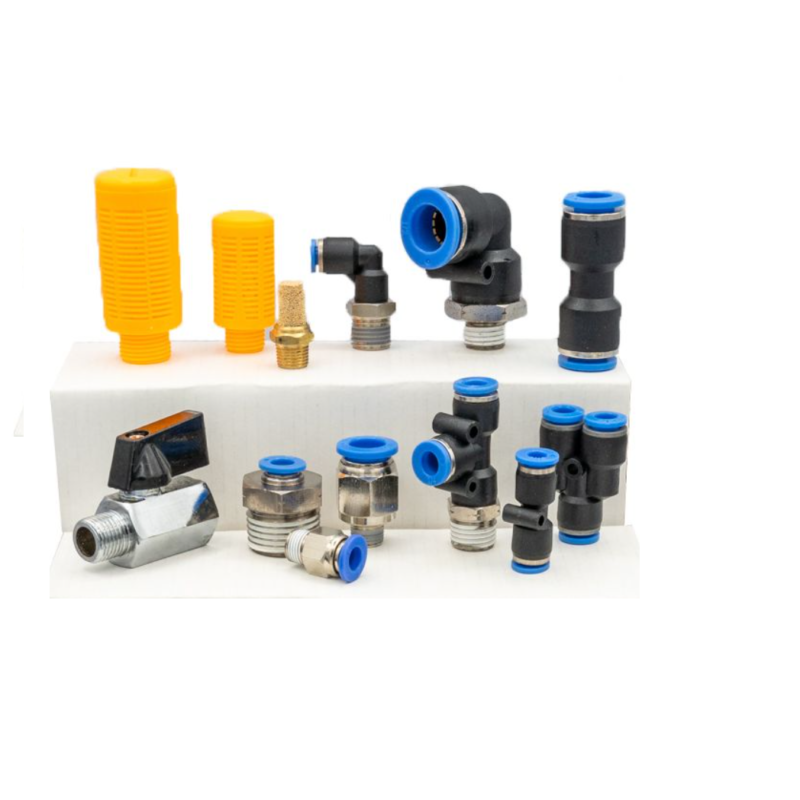Pneumatic fittings are connectors used for connecting various parts of pneumatic systems, including tubes, pipes, and hoses. They carry compressed air and are distinguished by tighter seals and lower pressure requirements when compared to hydraulic fittings. Fittings are possibly the most crucial of all the elements in the overall pneumatic system design, although they are the smallest. Pneumatic fittings, along with pipes, hoses, and tubes, connect all of the other essential components, and as a result, can have a significant impact on the overall system's safety, energy consumption, and efficiency.
In order to choose the right pneumatic fitting, we are here to help you make the right choice. Here are 5 basic tips you can consider when selecting a pneumatic fitting.
- Working Pressure
Based on the requirements of the equipment and what it's supposed to do, pneumatic fittings are usually rated for certain working pressure ranges. This pressure range shows when a pneumatic system will work at its best. If the correct working pressure is not maintained, the entire system may fail, with components leaking, breaking, or losing their pressurized seal. So, if your system works above or below the particular operating pressure, then its performance will be poor. If the pressure is too high, it can cause bursts and leaks, causing the system to fail. If below, then most likely it will not function properly because of a lack of input energy.
- Working Environment
Piping and pneumatic fittings should be constructed to provide the required flow without causing large pressure dips; in general, making the piping as uncomplicated as possible will lower energy loss through the system. For example, you can avoid using elbows when straight runs are possible.
Let’s dive into some environmental factors you need to consider:
Operating Temperature - The operating temperature shows the proper temperature range that is particular to that pneumatic fitting under which it can operate. The temperature can be measured in two degrees - Celsius (°C) and Fahrenheit (°F). If the fitting is forced to work outside of the particular temperature range, it will probably fail. It's important to remember that the compressed air output is affected by the ambient temperature (sometimes named room temperature) of the incoming air to the compression unit.
You can use industrial automation equipment only in a regulated temperature environment because pressure lowers when air heats up or rises. In general, every 5°F reduction in temperature results in a 1% increase in efficiency and power saving. However, low intake pressures and high ambient air temperature have a substantial impact on performance. It's also true that as the working temperature rises, the operating pressure of nylon tubing and polyurethane decreases.
Contaminants - Common air pollutants are water, oil, and particles such as rust, dirt, etc. The filtration system, which normally consists of a filter-regulator-lubricator unit (FRL), is used to remove such pollutants from the air intake. In some types of compressors, the lubricant also serves as a coolant, although there is a possibility of the hot lubricant returning into the inlet air and contaminating it.
Space - It's critical to provide enough space around the installation to enable the best possible construction as well as maintenance and repair access. It should be wide enough to provide space for pipes to run easily and allow a free flow of ambient air which can prevent the space from overheating. In addition, the equipment must be stable and free of vibration.
These were some of the common environmental factors you can consider.
- Material of the Fitting
When determining how to select the right pneumatic fittings for your application, look at the various materials that are typically used to identify their reaction to temperature changes, physical properties, etc. The common materials are:
- Aluminum - Being a lightweight metal that is corrosion-resistant and also has low tensile strength, aluminum is ideal for low-pressure applications.
- Stainless Steel - Stainless steel is a strong metal that resists chemicals and corrosion well. This metal provides the strength and endurance of steel, as well as exceptional corrosion resistance.
- Plastic - Polypropylene is a thermoplastic commonly used for pneumatic fittings because of its great durability, low cost, and great compatibility with various materials. As it's resistant to ozone, weathering, and UV radiation, it can be used in exposed areas.
- Brass - This is a sturdy, long-lasting, and corrosion-resistant metal. Brass has high machinability and performance qualities. As a result, it's a common metal for smaller compression and threaded fittings, which are typical in pneumatic systems.
- Composites - Composite fittings are constructed from a variety of materials, including carbon, fibreglass, and graphite. They have high melting temperatures, making them suitable for applications requiring high-temperature endurance and chemical resistance. Thermal and electrical conductivity are similarly low in these materials.
- Approvals
By considering the safety standard and industry, you need to install a relevant fitting in certain application use cases. For instance, in the case of the food industry, you need to know which fitting is the best and how to install and maintain it. This location has high air purity requirements, which may restrict the usage of compressors that employ oil-based lubricants. Bacteria and microbes are also a key cause of concern. So, you need to pay attention to safety standards to provide optimal performance for your systems.
- Types of Vessels and Connections
When choosing pneumatic fittings, consider the type and size of tubing or hose you'll need, as well as whether it'll be measured in imperial or metric sizes and whether it'll be composed of metal or thermoplastic. And, first and foremost, you must distinguish between pipe, tube, and hose.
And also consider which type of fitting connections you need for your industrial needs, including push-in fittings, threaded, barb-to-barb fittings, etc.
If you have any questions regarding pneumatic fittings, don’t hesitate to contact HAK Fluid Power Equipment LTD, based in Toronto, Canada. Browse the selection today and find the best pneumatic fittings that meet your needs.

